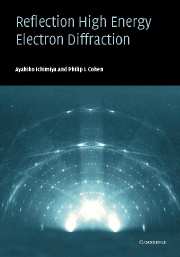Book contents
- Frontmatter
- Contents
- Preface
- 1 Introduction
- 2 Historical survey
- 3 Instrumentation
- 4 Wave properties of electrons
- 5 The diffraction conditions
- 6 Geometrical features of the pattern
- 7 Kikuchi and resonance patterns
- 8 Real diffraction patterns
- 9 Electron scattering by atoms
- 10 Kinematic electron diffraction
- 11 Fourier components of the crystal potential
- 12 Dynamical theory – transfer matrix method
- 13 Dynamical theory – embedded R-matrix method
- 14 Dynamical theory – integral method
- 15 Structural analysis of crystal surfaces
- 16 Inelastic scattering in a crystal
- 17 Weakly disordered surfaces
- 18 Strongly disordered surfaces
- 19 RHEED intensity oscillations
- Appendix A: Fourier representations
- Appendix B: Green's functions
- Appendix C: Kirchhoff's diffraction theory
- Appendix D: A simple eigenvalue problem
- Appendix E: Waller and Hartree equation
- Appendix F: Optimization of dynamical calculation
- Appendix G: Scattering factor
- References
- Index
11 - Fourier components of the crystal potential
Published online by Cambridge University Press: 06 July 2010
- Frontmatter
- Contents
- Preface
- 1 Introduction
- 2 Historical survey
- 3 Instrumentation
- 4 Wave properties of electrons
- 5 The diffraction conditions
- 6 Geometrical features of the pattern
- 7 Kikuchi and resonance patterns
- 8 Real diffraction patterns
- 9 Electron scattering by atoms
- 10 Kinematic electron diffraction
- 11 Fourier components of the crystal potential
- 12 Dynamical theory – transfer matrix method
- 13 Dynamical theory – embedded R-matrix method
- 14 Dynamical theory – integral method
- 15 Structural analysis of crystal surfaces
- 16 Inelastic scattering in a crystal
- 17 Weakly disordered surfaces
- 18 Strongly disordered surfaces
- 19 RHEED intensity oscillations
- Appendix A: Fourier representations
- Appendix B: Green's functions
- Appendix C: Kirchhoff's diffraction theory
- Appendix D: A simple eigenvalue problem
- Appendix E: Waller and Hartree equation
- Appendix F: Optimization of dynamical calculation
- Appendix G: Scattering factor
- References
- Index
Summary
Introduction
In the dynamical theory of electron diffraction we intend to make use of the translational periodicity of a surface to write the scattered electron wave function as a sum of beams or Fourier components. The scattering properties of these beams will depend in turn upon the Fourier components of the crystalline potential. Because of the nature of the interaction between high-energy electrons and the crystal, this potential can be parametrized in a particularly simple and useful form. As a comparison, for LEED calculations this Fourier expansion method could be used in principle, but in that case one would need a large number of Fourier components for the calculation to converge (Pendry, 1974). For LEED, one also needs to include exchange scattering in the calculation, complicating the potential. For RHEED calculations, the cross section for exchange is negligibly small because of the large difference in energy between the atomic electrons and the incident and diffracted electrons.
The main goal of this chapter will be to determine an expression for the Fourier components of the crystalline potential that will be suitable for use in a dynamical calculation of surface structure. The only approximation that we will make will be to assume that the distribution of electrons around the atoms in a crystal is spherically symmetric. This means we are assuming that scattering from the atom cores dominates.
- Type
- Chapter
- Information
- Reflection High-Energy Electron Diffraction , pp. 154 - 160Publisher: Cambridge University PressPrint publication year: 2004



